Outerplace
with Alex Villar
A site-specific project for LichthausPlus Neue Kunst, Bremen, 2000.
The project consisted of 4 parts:
1) Production of posters distributed in the town.
2) Construction of a temporary “alternative entrance” as well as “film-set”.
3) Research, interviews and discussions for a fictive science-fiction movie.
4) Presentation of the material collected through the research, interviews and discussions.
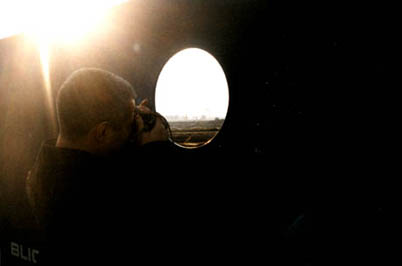  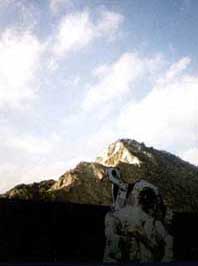
The artist Alex Villar and I were invited to collaborate on a project in the Lichthaus in a suburb of Bremen called Groebelingen. When researching, we decided we had to address the situation in which the suburb was found at the time of the exhibition: Right around the Lichthaus (and also right around Groebelingen) one of the biggest shopping/infotainment-centers in Northern Europe was under construction. Here, cinemas, shops, restaurants, supermarkets etc. etc. will soon be found in a very high concentration. It is almost as if a whole new city is being built - only of course a “city” in which one will not be a citizen (with rights), but rather a consumer (with money, one hopes). The new shopping center is presented, branded and rather aggressively promoted locally as well as regionally with images deriving from a certain cinematic as well as cold-war mythology: "the outer space." Thus the name of this new complex of buildings: The Space Park.
We decided to address some of the ways the hierarchies of power become visible in the mechanisms — economical, architectural as well as imaginary — involved in constructing the “Space Park”.
We wished to obstruct or “break open” the closed circulation of imagery, which doesn’t allow readers to disagree, only to consume. Our strategy was to appropriate the language of the Space Park; the kinds of words and images, but then to re-invent and re-employ them in relation to Groebelingen, though this time in collaboration with the inhabitants.
Our focus was on this paradoxical attempt at articulating (narrating, defining, branding) the area anew: The "colonization" of Groebelingen, which was hence — along the logic of the image campaign — symbolically articulated as an "outer space" itself; a kind of empty untouched ground without any history, had it not been for this new "discovery" (re-building, re-defining) of the area.
The Groebelingen we met had strong traces of working-class history mixed with the closely related immigrant-culture, in particular Turkish and Kurdish. However, these were obviously not understood as valuable or desirable images in the branding of the area, and were thus to be erased in this symbolical as well as very real (as well as very effective) re-writing of the area.
1) Poster
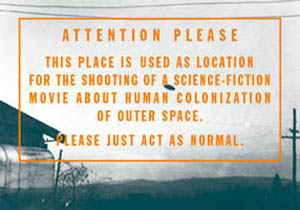
“Attention please. This site is used as location for the shooting of a science-fiction movie about the colonization of outer space. Please just act as normal.”
The text was on top of a typical b&w blurry “real” photo of a U.F.O. The idea was to present the “space” metaphor as one of fiction, and not only fiction as such, but especially the western (esp. American) cinematographic construction of certain fantasies, a construction which was especially powerful during the cold-war and the the “fight” between free-market capitalism and plan-economy. These images were certainly not randomly chosen for the branding of the new giga-shopping mall. In relation to this, we also wished to suggest that the fiction-machine of making movies and television could influence practical, everyday life of a small local community in a very real, practical way. Moreover, we also wished to introduce our project by playfully (perhaps even ironic) tapping into some of the complex and schizophrenic ideas of the history as well as production-logic of cinema in relation to ideas of “new space”.
The poster was printed and offered to people through small family-shops and local events in the area. It became quite popular and could be seen hanging on doors and in windows of shops and private homes in Grobelingen.
2) Alternative Entrance
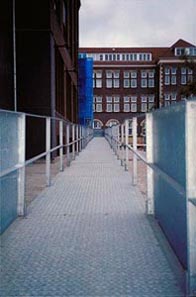  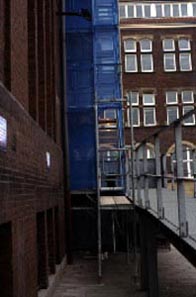  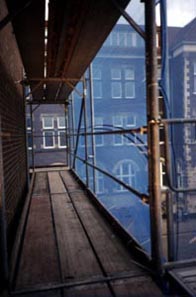
In the discussions about “space” it was inevitably clear that the specific architecture of the Lichthaus had to be addressed. The Lichthaus is the building that used to hold the management of the old shipbuilding yard and now contains amongst others our hosts as well as the managing direction of the new Space Park-corporation while their future buildings were under construction.
Interestingly, though the Space Park is such a big project (or perhaps exactly because of that), there is no communication between the local community and the developers. The Lichthaus is placed exactly between the dwellings and the moon-like construction-site landscape rapidly developing.
People living in Groebelingen rarely enter the building, which has been has a newly renovated, impressive, very symmetrical entrance, which leads up to an expensive restaurant (used by the people working in the house) and reception. This entrance is in itself intimidating for not-already-invited guests.
We decided to address this entrance by building an “alternative entrance” as our "stage set" for the fictive science-fiction movie: With scaffolding material normally used at construction sites, we built an alternative entrance to the Lichthaus. Our new entrance took the visitor away from the wide, symmetric stairs and big, classic columns leading to the main entrance, and instead lead the visitor along the side of the building, up a ramp, onto the scaffolding which on the level of the 2nd floor lead around the corner of the building and through a window into a bathroom-stall. From here, the rest of the building could be explored. It could be entered "from behind", so to speak.
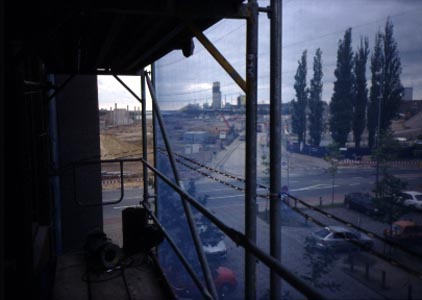  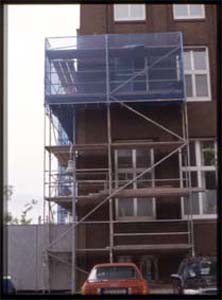   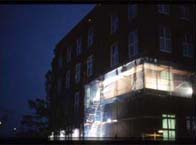 
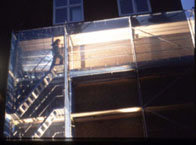  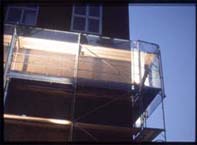
When entering the Lichthaus through this alternative entrance, one would walk on the outside of the building, looking to the one side over Groebelingen and down on the construction-site of the Space Park. People who entered through the scaffolding where offered a stamp which could be put to use wherever they wanted. It asked "Who is the Astronaut?", and could be chosen in German, English, Turkish or Kurdish.
3) Research for movie-production
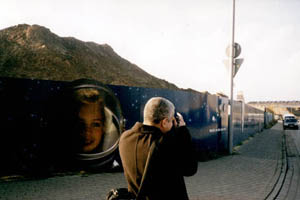  
Instead of serving another package of imagery, parallel to that of the Space Park, we wanted to offer the imagery and narrations as a language for use; one which people can talk with, rather than one in which they are talked to; a language that is not only designating, but can also be taken over and turned around; re-addressing the power that seems to think it owns it. Using this language actively as a way of discussing Groebelingen with people living there was an attempt to spark off other ideas and ways of imagining the area, than the ones the Space Park offered.
We put ourselves in the position of being film-workers, and invited people of Groebelingen to join us in imagining and researching for a science-fiction movie which was to be shoot in and about Groebelingen. We asked people for possible stories, real or fictional, sites, backgrounds, but also for scenarios of Grobelingen-in-the-future.
We interviewed people in Groebelingen about what they could imagine for the future Groeblingen, asking them to let their fantasy run wild, and not to keep it restricted by “reality” such as the numbers of unemployed, closed shops, decreasing real-estate value etc. (all the depressing facts that had been the arguments used to justify the construction of the Space Park).
Through the idea of a production of a film we asked people to speak about their town and community in a very different way than normally: Full of fantasy, desire, imagination and most of all images. In our reference to cinema we aimed at activating all the romantic clichés, dreams and glamorous myths of the movie-industry and its "ready-made" images of the future. However, when asking people about how and where and what they imagined for this project, we found that the imagery very quickly turned into specific local narrations where it could be re-employed in order to deal with very specific, local contents.
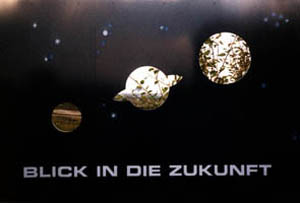
Some images from our "reference library" — images we used when talking to people.
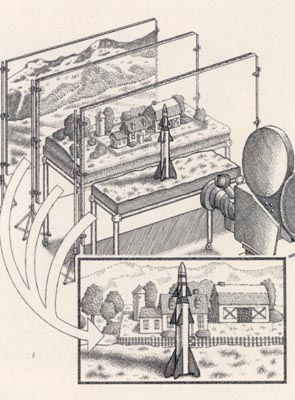  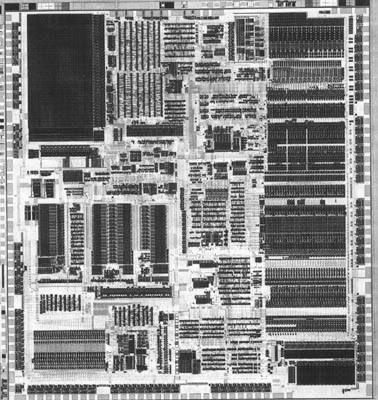   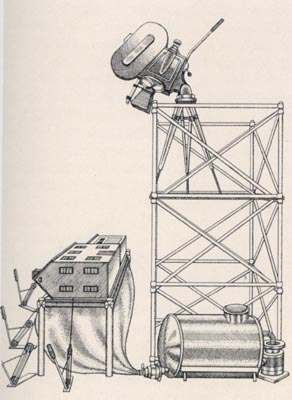       
4) Presentation of research material
—Still in process
|